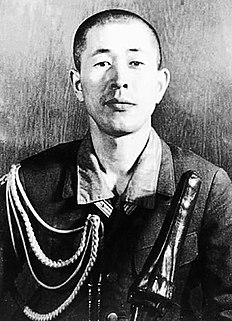
Sir Kazuo Ishiguro, is an English novelist, screenwriter, and short-story writer. He was born in Nagasaki, Japan, but his family moved to the UK in 1960 when he was five. Ishiguro graduated from the University of Kent with a bachelor's degree in English and Philosophy in 1978 and gained his master's from the University of East Anglia's creative writing course in 1980.

The Saitama Seibu Lions are a professional baseball team in Japan's Pacific League based north of Tokyo in Tokorozawa, Saitama. Before 1979, they were based in Fukuoka in Kyushu. The team is owned by a subsidiary of Prince Hotels, which in turn is owned by the Seibu Group. The team experienced a recent period of financial difficulty, but the situation brightened when the team received a record ¥6 billion posting fee from the Boston Red Sox for the right to negotiate a contract with Daisuke Matsuzaka. Between 1978 and 2008, the team logo and mascot were based on the adult version of Kimba the White Lion, a classic Japanese anime series by Osamu Tezuka. In 2004, former Seibu Lions player Kazuo Matsui became the first Japanese infielder to play in Major League Baseball.

Kazuo Koike is a prolific Japanese manga writer (gensakusha), novelist and entrepreneur.
Mono no aware(物の哀れ), literally "the pathos of things", and also translated as "an empathy toward things", or "a sensitivity to ephemera", is a Japanese term for the awareness of impermanence, or transience of things, and both a transient gentle sadness at their passing as well as a longer, deeper gentle sadness about this state being the reality of life.
Kazuo is a masculine Japanese given name.
Michinori Shiraishi was a Lieutenant Colonel in the Imperial Japanese Army during World War II. He was brother-in-law to General Takeshi Mori, commander of the First Imperial Guards Division, in charge of defending Tokyo and the surrounding region.

Yakuza Graveyard, known in Japan as Yakuza no Hakaba: Kuchinashi no Hana, is a 1976 Japanese yakuza film directed by Kinji Fukasaku. The screenplay by Kazuo Kasahara is based on a concept by Norimichi Matsudaira, Naoyuki Sugimoto and Kyo Namura.

Detective Conan: Full Score of Fear is the twelfth movie installment of the Detective Conan manga and anime franchise. The initial screening of the movie was scheduled on April 19, 2008. An OVA, which takes place three years earlier, was released specially for the movie. The OVA was released go Shogakukan on DVD as Magic File # 2.

The Kyūjō incident was an attempted military coup d'état in the Empire of Japan at the end of the Second World War. It happened on the night of 14–15 August 1945, just before the announcement of Japan's surrender to the Allies. The coup was attempted by the Staff Office of the Ministry of War of Japan and many from the Imperial Guard to stop the move to surrender.
Hideki Mori is a Japanese manga artist. He made his professional debut in 1982 in Shōnen Sunday, after which he was chosen by Kazuo Koike to illustrate the continuation of Lone Wolf and Cub, Shin Lone Wolf and Cub. Mori is best known for his manga adaptation of Kenichi Sakemi's historical novel Bokkō, which was then adapted as the movie A Battle of Wits. Mori received the 1995 Shogakukan Manga Award for general manga for Bokkō. His other works include Umizuru and Aozora Shot, and the illustrations for Kajō. He is noted for his detailed art in a realistic style.

Final Yamato is a 1983 Japanese anime science fiction film and the fourth theatrical movie of the Space Battleship Yamato saga. The 70mm print had a running time of 163 minutes, making Final Yamato the longest running animated film ever made.
Suzakumon, is a 1957 color Japanese film directed by Kazuo Mori and based on a novel by Matsutarō Kawaguchi. At the 1957 Asia-Pacific Film Festival the film won awards for best film and best cinematography. The film also won a special award at the 1958 Mainichi Film Concours.

Detective Conan: The Raven Chaser is the thirteenth movie installment of the Detective Conan manga and anime series. The movie was released in Japan on April 18, 2009. This movie earned 3.9 billion yen in the domestic Japanese box office, making it the highest-grossing movie in the Detective Conan series. The movie involves active members of the Black Organization, making this the Black Organization's second appearance in a movie since Countdown to Heaven. A special preview to the movie aired in Japan on Animax. A new member from the Black Organization that shrunk Shinichi's body manages to find out about Shinichi's transformation into Conan. This discovery starts to put those around him in danger as Gin and the other Black Organization members start to take action. The film was nominated for best animated film at the 2010 Awards of the Japanese Academy.
Kazuo Mori was a Japanese film director who primarily worked in popular genres like the jidaigeki.
The 1983 World Figure Skating Championships were held in Helsinki, Finland from March 8 to 13. At the event, sanctioned by the International Skating Union, medals were awarded in men's singles, ladies' singles, pair skating, and ice dancing.
Japanese settlement in what now constitutes modern-day Federated States of Micronesia (FSM) dates back to the end of the 19th century, when Japanese traders and explorers settled on the central and eastern Carolines, although earlier contacts can not be completely excluded. After the islands were occupied by Japan in 1914, a large-scale Japanese immigration to them took place in the 1920s and 1930s. The Japanese government encouraged immigration to the islands belonging to the South Pacific Mandate to offset demographic and economic problems facing Japan at that time.
Mizutani is a Japanese surname. Notable people with the surname include:
Kazuhiro Mori is a retired Japanese cyclist.







